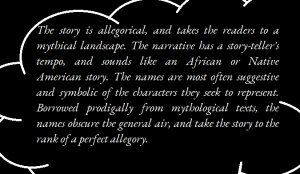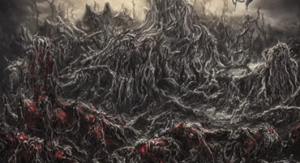Mahesh Paudyal
Madhukar Suvedi is a name seldom heard of among men of letters in Nepal. There is no question, therefore that his works are in readers’ and critics’ list. But it often turns out to be so: some unheard of names and unread things turn out to be rare gems under the deep ocean trenches. They only need to be unveiled and publicized.
This is what came to my mind after I read A Legend of the Old Sins. The print quality and layout of the books is so pathetic that one would seldom pick it up from a store, and flip pages for reading. But I dared at the suggestion of a friend, and was blessed. I couldn’t help flaying the publisher for the sheer injustice to the book which, in a well-edited version and high quality print, would stun not only Nepalese readership, but even the international audience.
This cute book in English is a touchtone, a rare model of what storytelling could best be, if handled carefully. It also is a powerful answer to those who are cynical of world-class writing in English from Nepali authors. If typographical errors – that are publishers’ bungle and not that of the author – are to be ignored, the authorial presence is something that can shake Nepali writing in English.
Divided into 23 short chapters, it is the story of a village called Alpen – an interesting jumbling of the letters in Nepal – that lives in peace and harmony, as long as the laws made by ancestors are abided by. It is a model village, close-knit and harmonious. Males and females both rule the rustics, and gender is never a pretext for discrimination. Rule of law guides the land, and violators are not spared at any cost, no matter how close in relation they might have been with the rulers.
The exposition chronicles a flood in the Baulha River, forcing the villagers to move uphill, and found a new village called Alpen. Flanked by the Salleri grove, the village epitomizes peace and justice. After its ancestral patriarch Samaden dies, his widow Gargima takes over as the new chief and the legacy of just and benevolent rule continues. When she is quite old, she hands over the reign to her eldest son Vihang. Vihang’s son Hridan, the heir to the chieftainship, is still a boy.
The tide of the story takes an unexpected turn when Aavil (Evil), the youngest son of Gargima tries to molest a villager’s wife. The guilty is immediately caught, and brought to justice. At the order of Gargima – his own mother, the village chief and the culprit’s brother Vihang executes a third-degree corporeal punishment, till Aavil can bear it no longer. Following the punishment, he exiles himself, and is not seen around for quite a long time.
After a few days, Vihang, the chief goes missing, and is never found again. Gargima the old matriarch once again takes the charge of the chieftainship. Aavil suddenly reappears in the village with a coterie of eleven evil men, and claims his right to power. This ushers an unexpected chaos into the village, and its peace is gone. Gargima, Hridan and Hridan’s mother Nan are forced to go on exile at Salleri, and against the will of the people Aavil rules Alpen, aided by his armed hooligans that slowly increase in number, and reach beyond thirty. The meek people abide by his unjust rules, one of which necessitates a man to marry none other than his own cousin.
Even as public discontent against the dictator fumes, the villagers find out that Aavil is the man who murdered Vihang, their former chief. Hridan unites the youths into an armed group, and plans for an attack. Hemanga, a close friend of Hridan, is arranged to marry Sami – a girl outside his cousinage – at Devi Than, the village shrine. Knowing that the evil was in the offing, Yawak, the dumb smith makes and hides as many sharp weapons – spears, harpoons, sickles and the like around Devi Than at the instruction of Hridan. On the day of the marriage, Hridan himself is all set to marry Sayana – also a girl outside his cousinage. This is a deliberate violation of the village rule, and an outright challenge to Aavil’s authority. Youths, girls and women – all armed to their teeth, get ready at strategic positions to face Aavil and his coterie.
When a group of vandals try to disrupt Hemanga’s marriage at Devi Than, women come out of home and slay one of them, and drive the others away. Enraged, Aavil brings in other men, and a terrible fight takes place. Hridan joins immediately, and the decisive battle commences. Aavil’s men fall one after another, and some flee to save themselves. Yawak, the dumb blacksmith fights with Aavil with all his might and finishes the tyrant, before he attains martyrdom. The cruel rule of Aavil ends, and Alpen gets back its lost peace.
The story is allegorical, and takes the readers to a mythical landscape. The narrative has a story-teller’s tempo, and sounds like an African or Native American story. The names are most often suggestive and symbolic of the characters they seek to represent. Borrowed prodigally from mythological texts, the names obscure the general air, and take the story to the rank of a perfect allegory. The development of the story and the social setting before the catastrophe and denouement are comparable with Chinua Achebe’s Things Fall Apart. Only that, the parts fallen apart in this case, are amended in the end, while in Achebe’s case the falcon cannot hear the falconer.
The story, apparently a plain narrative in the surface, bears several layers of meaning. The prodigal children of the same village foisting chaos upon the harmony of the village can be read in the political context of Nepal. The peace and harmony of Alpen are both ancient glory and dreams associated with Nepal. The turn-taking of males and females as chieftains makes an authorial prescription to our policy-makers, while Hridan’s deliberate design to subvert conventional and irrational marriage codes advocates change and progressive initiatives in the society, leading to a social revolution. The most powerful message of the narrative probably is the fact that in the life of a nation, both problems and solutions lie within. Only that, one needs the wisdom to identify, and deal with them appropriately.
I cannot help commending the author for such a groundbreaking work. Let everyone read it once!
Books: A Legend of the Old Sins
Author: Madhukar Suvedi
Publisher: Bibek Sirjanshil Publication
[Paudyal is a faculty at the Central Department of English, TU]










